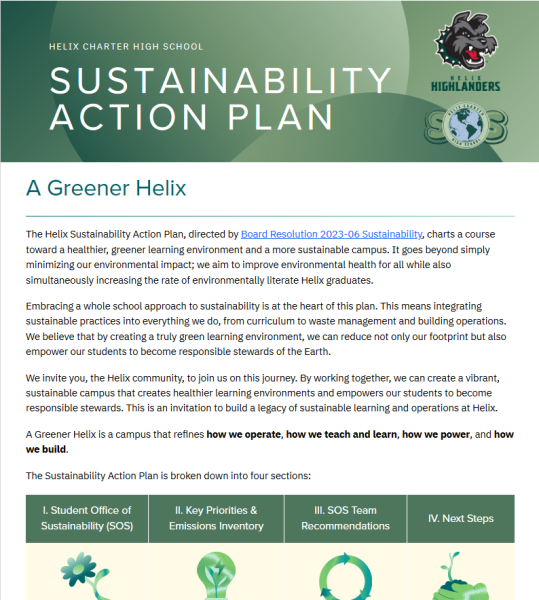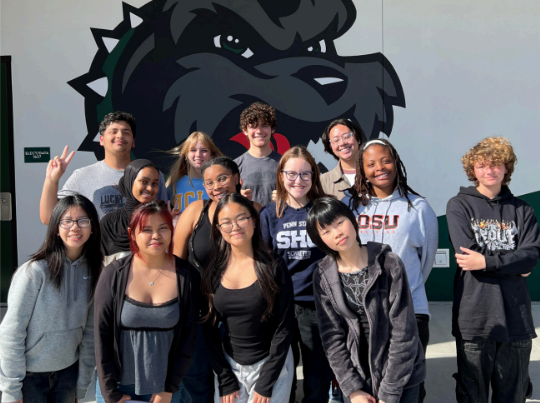From Sept. 2023, to May 2024, Kevin Myron and the Student Office of Sustainability (SoS) developed and refined Helix’s first Sustainability Action Plan. Through months of collaboration and determination, the campus finally has a roadmap for addressing sustainability.
SoS is a student-led organization committed to promoting sustainability within the Helix community. The office is divided into smaller groups that focus on different aspects of the plan. By collecting data on campus, consulting local experts, and engaging with students and staff, the office has identified key recommendations to improve sustainability at Helix.
What is the Sustainability Action Plan? Our SAP (Sustainability Action Plan) is divided into multiple sections, each addressing specific sustainability challenges on campus. The plan primarily focuses on four key areas:
- How the school operates.
- How it teaches and learns.
- How it powers its facilities.
- How it builds for the future.

Click Here to learn more about the Sustainability Action Plan
The SAP is a foundational guide for Helix’s administration and charter board. It outlines recommendations from the SoS and details current initiatives and proposed solutions.
The Sustainability Action Plan has already led to significant progress at Helix, with one of the most impactful achievements being the transition to renewable energy. By joining San Diego Community Power 100,
Another key step forward is the installation of electricity submeters, funded by a $2,000 grant from Renew Our Schools. These submeters will let the campus track solar energy generation and overall energy use in real-time. Each term, Helix will participate in a nationwide effort to reduce energy consumption through student-led campaigns, with the first set to launch in late November.
This initiative has immediate and long-term benefits. Real-time tracking allows the campus to pinpoint areas where energy is wasted and take actionable steps to reduce consumption. As energy use decreases, so do electricity costs and the school’s carbon footprint. The data also gives students hands-on experience with energy management, helping them develop skills they can apply at home and in their communities.
Beyond energy, the Sustainability Action Plan addresses several other critical areas:
- Indoor Air Quality: Helix plans to join the Healthy Green Schools & Colleges program to improve air quality and create healthier learning spaces for students and staff.
- Waste Management: The school is working to standardize recycling, compost, and landfill bins across campus to increase waste diversion.
- Transportation: Electric vehicle chargers will be installed in the parking lot, supporting cleaner transportation options.
- Renewable Energy: By opting into Power100, a program that provides our campus with clean and renewable energy, with San Diego Community Power, Helix is committing to 100% renewable and carbon-free electricity.
Helix is also working on an interdisciplinary pathway for sustainability outside the Sustainability Action Plan, including history, English, and science courses. This pathway will allow students to develop a broad understanding of sustainability and its practical application to real-world environmental problems. It aims to benefit those pursuing environmental careers and students in other fields, offering knowledge they can use daily.

Kevin Myron, Helix’s science teacher and sustainability coordinator, sees the Sustainability Action Plan as a critical tool for the school’s sustainability efforts. He emphasizes that the plan lays out goals, timeframes, and costs, providing a structured guide for students, staff, and administrators. Myron explains how the Sustainability Action Plan is vitally Important. “It holds us accountable, shows what we’ve done so far, and helps us see whether we’re on track or need to adjust,” he emphasized. Myron also added that the student-led nature of the plan ensures it resonates with the campus community.

“It’s coming from a student perspective, coming from a student’s mouth,” he stressed. While the plan has made significant progress, Myron acknowledged room for improvement. He pointed to accessibility and clarity as areas needing attention, noting that the plan had not been publicly shared until now. He stressed the importance of making it available to internal and external stakeholders to encourage broader understanding and support. Reflecting on the work, Myron highlighted the need for institutional backing. “We’ve seen a lot of progress, but sustainability can’t be the responsibility of just one person or a group of students,” he said. He called for higher administrative and facilities support to ensure the plan’s long-term success.

